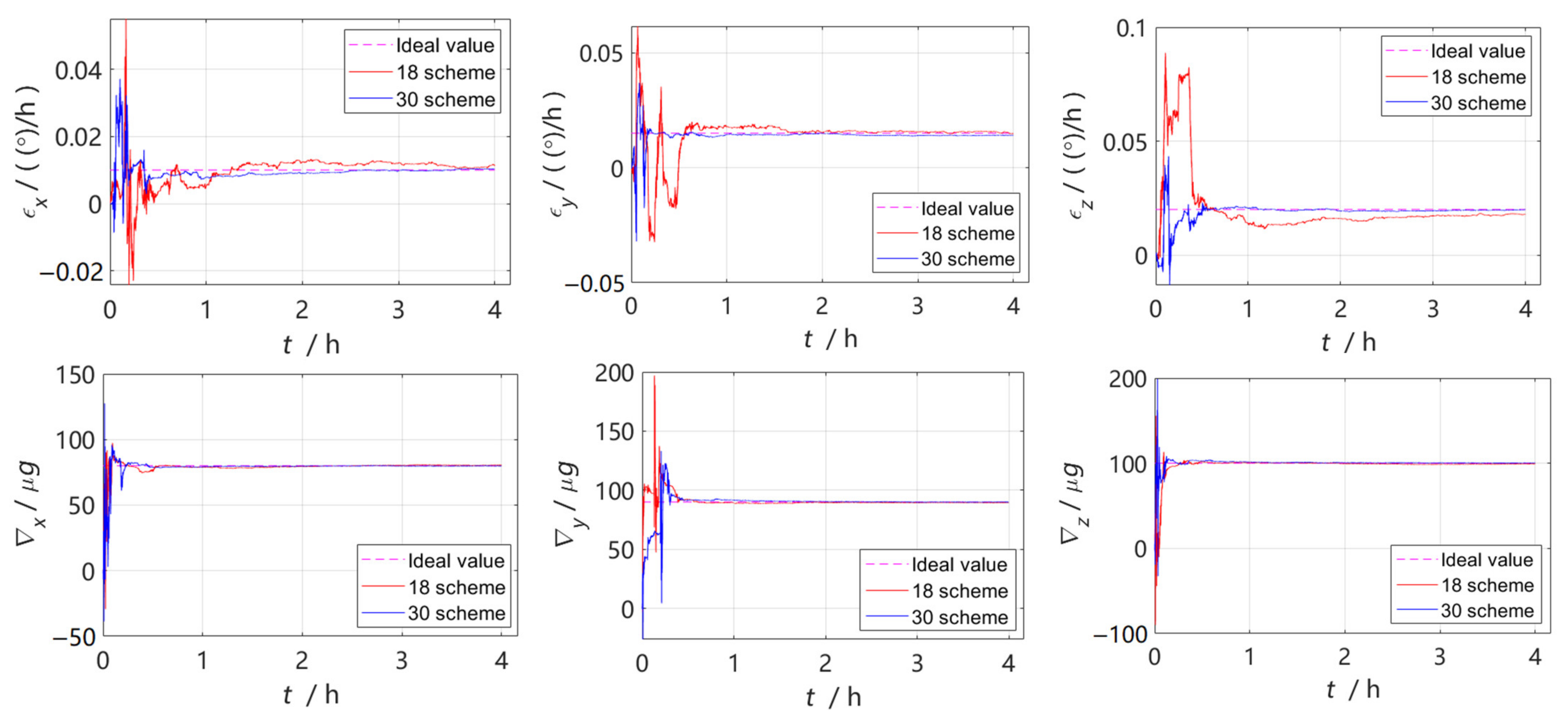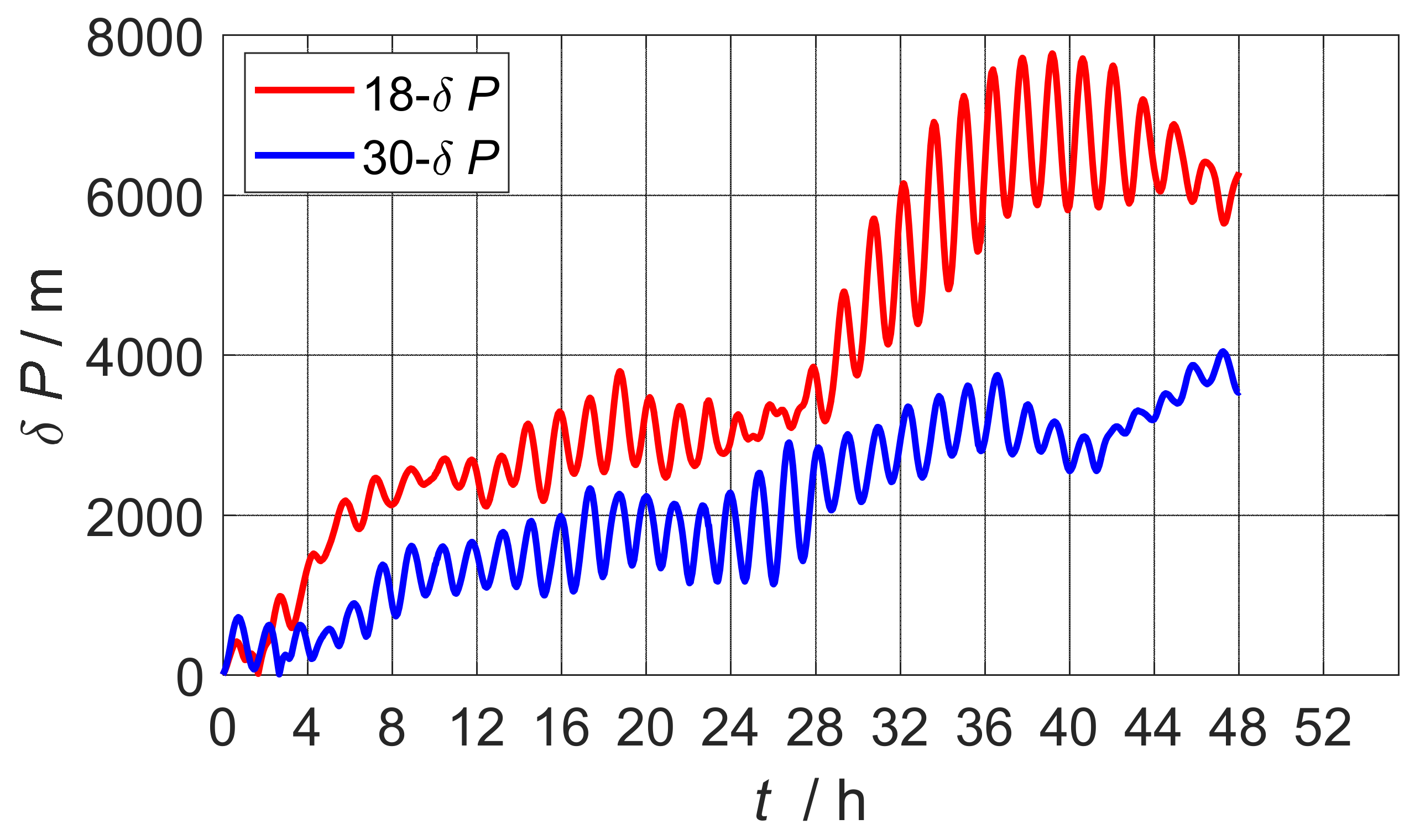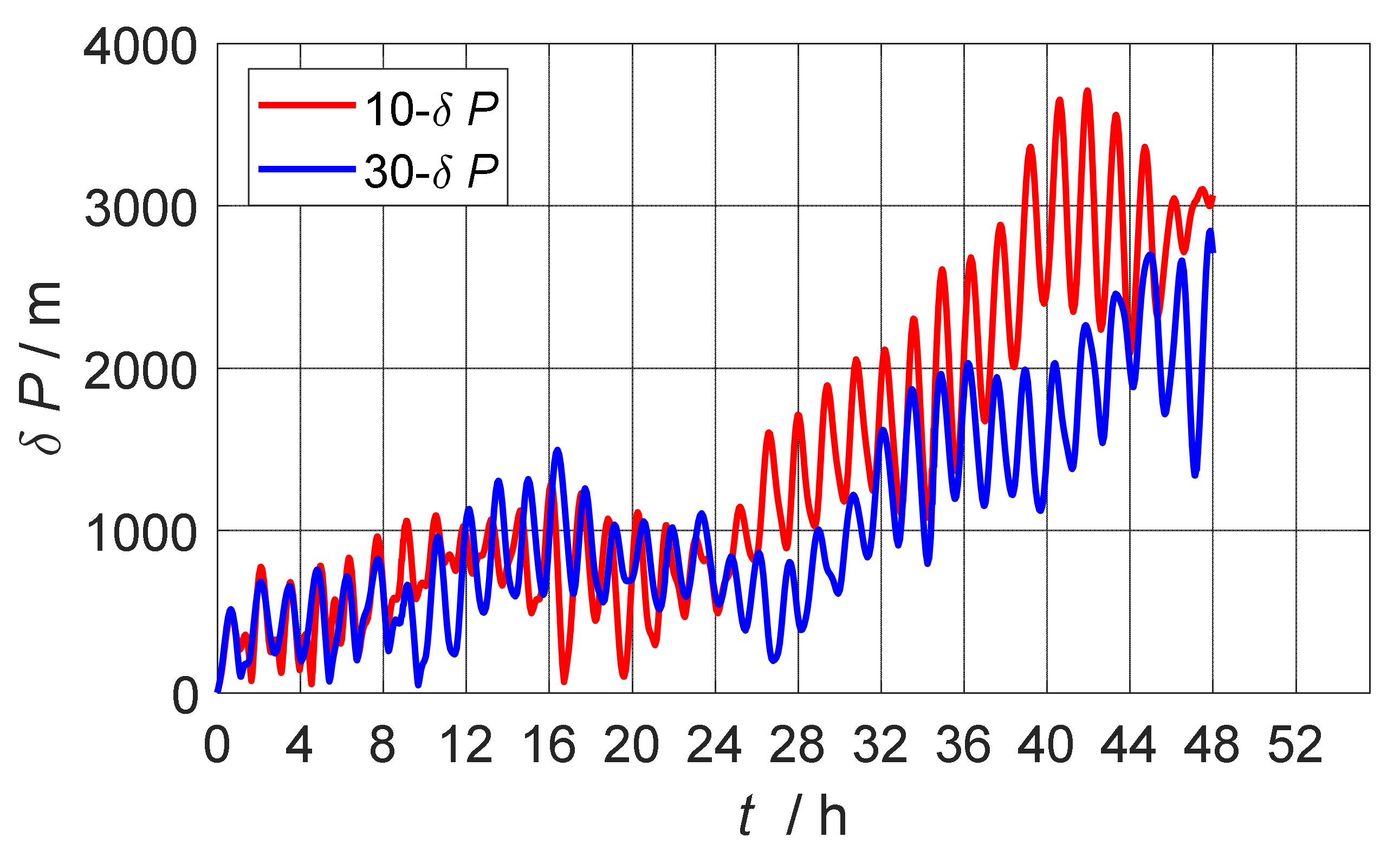An Improved System-Level Calibration Scheme for Rotational Inertial Navigation Systems
Abstract
:1. Introduction
2. IMU Error Model
2.1. Definition of Reference Frames
2.2. Definition of System Errors
2.3. Establishment of IMU Error Model
3. System-Level Calibration Based on 30-Dimensional Kalman Filter
3.1. Establishment of Kalman Filter
3.2. Calibration Arrangement Scheme
3.3. INS Observability Analysis
4. Verification of Simulations and Experiments
4.1. Simulations Verification
4.2. Experiments Verification
5. Conclusions
Author Contributions
Funding
Institutional Review Board Statement
Informed Consent Statement
Data Availability Statement
Conflicts of Interest
References
- Poddar, S.; Kumar, V.; Kumar, A. A Comprehensive Overview of Inertial Sensor Calibration Techniques. J. Dyn. Syst. Meas. Control 2017, 139, 011006. [Google Scholar] [CrossRef]
- Wang, Z.; Cheng, X.; Fan, S. Eight-position systematic calibration method for SINS based on two-axis turntable with temperature compensation. J. Chin. Inert. Technol. 2019, 27, 23–31. [Google Scholar]
- Deng, Z.; Sun, M.; Wang, B.; Fu, M. Analysis and Calibration of the Nonorthogonal Angle in Dual-Axis Rotational INS. IEEE Trans. Ind. Electron. 2017, 64, 4762–4771. [Google Scholar] [CrossRef]
- Fan, H.; Xie, Y.; Wang, Z.; Wang, L.; Luo, H.; Yu, X. A unified scheme for rotation modulation and self-calibration of dual-axis rotating SINS. Meas. Sci. Technol. 2021, 32, 115113. [Google Scholar] [CrossRef]
- Shi, W.; Wang, X.; Zheng, J.; Zhan, D.; Wang, Y. Multi-position systematic calibration method for RLG-SINS. Infrared Laser Eng. 2016, 45, 99–106. [Google Scholar]
- Chang, L.; Qin, F.; Xu, J. Strapdown inertial navigation system initial alignment based on group of double direct spatial isometries. IEEE Sens. J. 2022, 22, 803–818. [Google Scholar] [CrossRef]
- Chang, L.; Di, J.; Qin, F. Inertial based integration with transformed INS mechanization in Earth frame. IEEE/ASME Trans. Mechatron. 2022, 27, 1738–1749. [Google Scholar] [CrossRef]
- Kozlov, A.; Tarygin, I.; Golovan, A. Calibration of Inertial Measurement Unit on a Low-Grade Turntable: Estimation of Temperature Time Derivative Coefficients. In Proceedings of the 23rd Saint Petersburg International Conference on Integrated Navigation Systems, Saint Petersburg, Russia, 30 May 2016. [Google Scholar]
- Yang, X.X.; Huang, Y. Systematic calibration method for laser gyro SINS. J. Chin. Inert. Technol. 2008, 16, 1–7. [Google Scholar]
- Quan, Z.Z.; Shi, Z.Y.; Wang, Y. Online calibration technology for strapdown inertial navigation system. Mod. Electron. Tech. 2012, 35, 8–131. [Google Scholar]
- Pittman, D.N.; Roberts, C.E. Determining inertial errors from navigation-in-place data. In Proceedings of the IEEE PLANS 92 Position Location and Navigation Symposium Record, Monterey, CA, USA, 23–27 March 1992; pp. 60–67. [Google Scholar] [CrossRef]
- Zhang, H.; Wu, Y.; Wu, W.; Wu, M.; Hu, X. Improved multi-position calibration for inertial measurement units. Meas. Sci. Technol. 2010, 21, 015107. [Google Scholar] [CrossRef]
- Wang, Z.; Xie, Y.; Yu, X.; Fan, H.; Wei, G.; Wang, L.; Fan, Z.; Wang, G.; Luo, H. A system-level calibration method including temperature-related error coefficients for a strapdown inertial navigation system. Meas. Sci. Technol. 2021, 32, 115117. [Google Scholar] [CrossRef]
- Emel’yantsev, G.I.; Blazhnov, B.A.; Dranitsyna, E.V.; Stepanov, A.P. Calibration of a precision SINS IMU and construction of IMU-bound orthogonal frame. Gyroscopy Navig. 2016, 7, 205–213. [Google Scholar] [CrossRef]
- Weng, H.N.; Gong, J.; Hu, X.M.; Gao, F.; Zhang, Y. Online self-calibration of hybrid FOG inertial navigation system. J. Chin. Inert. Technol. 2017, 25, 1–5. [Google Scholar]
- Hu, G.; Wang, W.; Zhong, Y.; Gao, B.; Gu, C. A new direct filtering approach to INS/GNSS integration. Aerosp. Sci. Technol. 2018, 77, 755–764. [Google Scholar] [CrossRef]
- Hu, G.; Gao, B.; Zhong, Y.; Gu, C. Unscented kalman filter with process noise covariance estimation for vehicular ins/gps integration system. Inf. Fusion 2020, 64, 194–204. [Google Scholar] [CrossRef]
- Hu, G.; Gao, S.; Zhong, Y. A derivative UKF for tightly coupled INS/GPS integrated navigation. Isa Trans. 2015, 56, 135–144. [Google Scholar] [CrossRef] [PubMed]
- Yang, X.X.; Meng, H.R.; Wang, S. Calibration method for laser gyro SINS under outer field dynamic conditions. J. Chin. Inert. Technol. 2011, 19, 393–398. [Google Scholar]
- Wang, Z.; Fan, H.; Xie, Y.; Luo, H.; Yu, X. System-level calibration method for complex error coefficients of strapdown inertial navigation system. Infrared Laser Eng. 2022, 51, 285–295. [Google Scholar]
- Camberlein, L.; Mazzanti, F. Calibration technique for laser gyro strapdown inertial navigation systems. In Proceedings of the Symposium, Stuttgart, West Germany, 24–25 September 1985; pp. 13–35. [Google Scholar]
- Yan, G.; Yang, X.; Su, X.; Weng, J.; Qin, Y. Error Distribution Method and Analysis of Observability Degree Based on the Covariances in Kalman Filter. In Proceedings of the 2018 37th Chinese Control Conference (CCC), Wuhan, China, 25–27 July 2018. [Google Scholar]





| Rotation Order | Rotation Scheme | Rotation Order | Rotation Scheme | ||
|---|---|---|---|---|---|
| Frame n | Frame IMU | Frame n | Frame IMU | ||
| 1 | E + 90° | y + 90° | 9 | E + 90° | x + 90° |
| 2 | E + 90° | y + 90° | 10 | E − 180° | x − 180° |
| 3 | E + 90° | y + 90° | 11 | E − 90° | x − 90° |
| 4 | E − 180° | y − 180° | 12 | N + 90° | z + 90° |
| 5 | E − 90° | y − 90° | 13 | N + 90° | z + 90° |
| 6 | N + 90° | z + 90° | 14 | N − 180° | z − 180° |
| 7 | E + 90° | x + 90° | 15 | N − 90° | z − 90° |
| 8 | E + 90° | x + 90° | The order (16~30) is the same as that of (1~15), and the direction is opposite | ||
| Parameter | 18-Position Scheme | 30-Position Scheme |
|---|---|---|
| 22.37 | 79.94 | |
| 23.08 | 69.69 | |
| 25.05 | 75.55 | |
| 181.52 | 251.99 | |
| 197.31 | 263.65 | |
| 170.47 | 247.22 | |
| 31.99 | 80.49 | |
| 65.02 | 95.85 | |
| 103.45 | 186.40 | |
| 64.07 | 154.33 | |
| 163.65 | 318.26 | |
| 103.46 | 225.95 | |
| 111.99 | 100.50 | |
| 158.46 | 155.51 | |
| 165.26 | 282.83 | |
| 274.16 | 332.01 | |
| 229.89 | 261.05 | |
| 452.96 | 633.62 | |
| 54.74 | 102.71 | |
| 174.74 | 244.61 | |
| 22.37 | 79.94 |
| Error Parameters | Ideal Value | 18-Estimate Value | 30-Estimate Value | 18-Residual Value | 30-Residual Value |
|---|---|---|---|---|---|
| 0.01 | 0.011301017 | 0.010314397 | 0.001301017 | 0.000314397 | |
| 0.015 | 0.014783523 | 0.014088555 | −0.000216477 | −0.000911445 | |
| 0.02 | 0.017859505 | 0.019863169 | −0.002140495 | −0.000136831 | |
| 80 | 80.45810632 | 79.83330178 | 0.458106325 | −0.166698218 | |
| 90 | 89.58384702 | 89.98982828 | −0.416152981 | −0.010171722 | |
| 100 | 99.2916787 | 100.3147819 | −0.708321297 | 0.314781869 | |
| 10 | 9.787512187 | 10.40013812 | −0.212487813 | 0.400138118 | |
| 20 | 20.15702346 | 20.20475451 | 0.157023456 | 0.20475451 | |
| 30 | 30.18298086 | 29.97072048 | 0.182980864 | −0.029279523 | |
| 10 | 10.07074401 | 9.96198043 | 0.070744014 | −0.03801957 | |
| 20 | 20.44490916 | 20.4155934 | 0.444909159 | 0.415593405 | |
| 30 | 30.15649279 | 30.15181757 | 0.156492792 | 0.151817574 | |
| 10 | 10.28440017 | 9.906793199 | 0.284400167 | −0.093206801 | |
| 20 | 19.36711027 | 19.67128246 | −0.632889727 | −0.328717541 | |
| 30 | 29.76259989 | 29.78869477 | −0.237400115 | −0.211305227 | |
| 10 | 9.902931167 | 9.750802654 | −0.097068833 | −0.249197346 | |
| −20 | −20.1225843 | −20.12456347 | −0.122584303 | −0.12456347 | |
| −30 | −30.28877323 | −29.80122684 | −0.288773226 | 0.198773161 | |
| 30 | 29.75675589 | 29.92631969 | −0.243244114 | −0.073680314 | |
| 10 | 10.67119009 | 10.06981142 | 0.67119009 | 0.069811417 | |
| −20 | −19.61482211 | −19.78829016 | 0.385177888 | 0.211709844 |
| Error Parameter | Calibration Value | ||
|---|---|---|---|
| Constant error of gyroscope (°/h) | −0.004108297 | 0.001381599 | 0.012232855 |
| Constant error of accelerometer (ug) | 112.5559752 | −53.77119242 | −128.2295866 |
| Scale factor error of gyroscope (ppm) | −11.72975729 | 3.722942935 | 10.07015303 |
| Scale factor error of accelerometer (ppm) | 211.7416169 | 109.248313 | 152.0861156 |
| Installation error of gyroscope (″) | 5.148117571 | 3.244895406 | 2.732270054 |
| Installation error of accelerometer (″) | 3.801944879 | −3.359659629 | −5.07799273 |
| 1.355994872 | 3.9076545111 | −2.908936285 | |
Publisher’s Note: MDPI stays neutral with regard to jurisdictional claims in published maps and institutional affiliations. |
© 2022 by the authors. Licensee MDPI, Basel, Switzerland. This article is an open access article distributed under the terms and conditions of the Creative Commons Attribution (CC BY) license (https://creativecommons.org/licenses/by/4.0/).
Share and Cite
Wei, Q.; Zha, F.; He, H.; Li, B. An Improved System-Level Calibration Scheme for Rotational Inertial Navigation Systems. Sensors 2022, 22, 7610. https://doi.org/10.3390/s22197610
Wei Q, Zha F, He H, Li B. An Improved System-Level Calibration Scheme for Rotational Inertial Navigation Systems. Sensors. 2022; 22(19):7610. https://doi.org/10.3390/s22197610
Chicago/Turabian StyleWei, Qiushuo, Feng Zha, Hongyang He, and Bao Li. 2022. "An Improved System-Level Calibration Scheme for Rotational Inertial Navigation Systems" Sensors 22, no. 19: 7610. https://doi.org/10.3390/s22197610
APA StyleWei, Q., Zha, F., He, H., & Li, B. (2022). An Improved System-Level Calibration Scheme for Rotational Inertial Navigation Systems. Sensors, 22(19), 7610. https://doi.org/10.3390/s22197610






